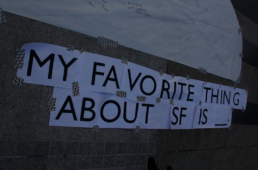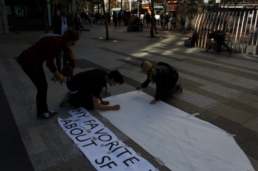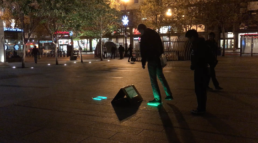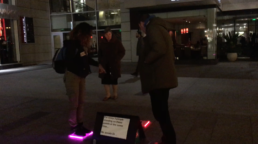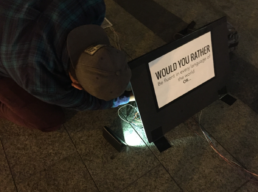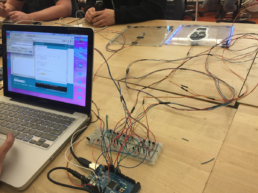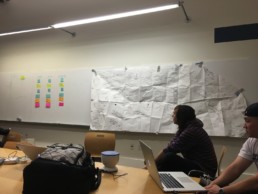
Together We Stand
Have you ever noticed how closed off people are when walking down the street? How they avoid eye contact and go out of their way (sometimes literally) to avoid interactions with people? We were challenged to disrupt a space using electronics in a way that helps people connect and create a collective dialogue.
AdvisorsNicholas PajerskiFieldsDigital Electronics, Interaction Design, Rapid PrototypingYear2015TeamEssie Kim
01
Approach
Through primary research and interviews, we gained a more holistic view of how this space could be used to connect people. After rapid prototyping some ideas, we found the most effective way to bring people together to have a conversation was through prompted interactions. The result was a voting system that helped people vote (and then donate money) to a specific cause. This helped begin a conversation with a stranger as well as convert the space from passive to interactive.
02
Prototype I
We laid out some butcher paper with the prompt “My favorite thing about SF is ____?” This allowed people to leave a mark in the space
Finding
People are more likely to participate when there are other people already involved
03
Prototype II
Our second prototype had to incorporate electronics to see people’s reactions to a technological intervention versus something simple like paper.
Finding
The LED lights helped draw people in and move them around the space but distracted people from voting on the prompt.
04
Prototype III
We wanted to see if people are more willing to participate if it’s for a greater cause and if they’re not obligated to donate money themselves. People are willing to invite strangers to complete the 3-person requirement, but some wanted to step on two panels at once.
Finding
- People are curious about the other charities people have chosen before them, and they prefer to have a list of charities.
- The space is dynamic according to the time of day; There are more individuals vs groups and they are busier in the afternoon compared to the evening.
05
Our Solution
Rapid prototyping was key in this project. We used low budget methods (i.e. butcher paper, foam core, sharpies) of prototyping to validate our ideas and assumptions in the space. This means that we prototyped and developed upon them each week as well as interviewed people about their interactions with space to better inform our next iteration.
One of the biggest challenges of this project was using electronics as means of disrupting the space. This was because we weren’t quite sure how willing people would be to interact an unfamiliar object in a familiar space. In the end we were able to successfully enable conversations in the space.


